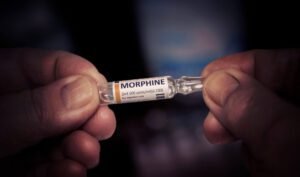Molly, also known as MDMA, is a popular synthetic drug that alters the mood and perception of users. Despite its reputation for providing euphoria, several studies suggest it comes with potential risks, including addiction.
In this section, we will explore whether Molly is addictive. We will also delve into the potential dangers of Molly use and the topic of MDMA addiction. By the end of this article, you will understand what Molly is, how it affects the body and mind, and what risks come with using it.
Key Takeaways
- Molly is a synthetic drug that alters the mood and perception of users.
- Using Molly comes with potential risks, including addiction.
- Understanding the risks associated with Molly use is crucial for those considering it.
- Recognizing the signs of dependency and seeking help is important for individuals dependent on the drug.
- Support and resources are available to those who are struggling with addiction.
Understanding Molly and Its Effects
MDMA, commonly known as Molly, is a synthetic drug that alters mood and perception. Consumption causes the brain to release a significant amount of serotonin and dopamine, two chemicals responsible for feelings of pleasure and happiness.
While the initial effects of Molly use may be euphoric, numerous risks are associated with the drug, particularly when it is abused. Regular and excessive Molly use can lead to long-term adverse mental and physical health effects.
Some of the risks of Molly abuse include the following:
- Dehydration due to excessive sweating
- Hyperthermia, or dangerously high body temperature
- Increased heart rate and blood pressure
- Seizures or convulsions
- Insomnia and other sleep disorders
- Depression and anxiety
Additionally, the long-term effects of Molly use can be severe and potentially irreversible. Prolonged use has been linked to:
- Memory loss and cognitive impairments
- Reduced ability to experience pleasure
- Anxiety and irritability
- Panic attacks and paranoia
- Increased risk of substance abuse and addiction
- Severe depression and suicidal ideation
It’s important to note that Molly use’s risks and long-term effects can vary depending on the frequency of use, dosage, and individual susceptibility.
“The risks of using Molly are real and can be severe. It’s important to understand the potential consequences of abusing this drug and to seek help if addiction becomes a concern.”
If you or someone you know is struggling with substance use disorder, it’s important to seek professional help. Numerous treatment options are available, including therapy, support groups, and rehabilitation programs. Seeking help is the first step towards recovery and regaining control of your life.
The Science Behind MDMA Addiction
Molly, also known as MDMA, is a drug that affects the brain’s chemistry by altering neurotransmitters such as serotonin, dopamine, and norepinephrine levels. When ingested, it produces euphoria, enhanced empathy, and increased energy, making it popular among party-goers and concert attendees. However, this drug can be dangerously addictive, and prolonged use can have severe consequences.
MDMA addiction is caused by changes in the brain’s reward system. When an individual consumes Molly, the drug increases the release of dopamine, a neurotransmitter responsible for feelings of pleasure and reward. This excess dopamine floods the system, causing the euphoric high associated with Molly use. However, over time, the brain’s reward system adapts to the excess dopamine, reducing the drug’s effectiveness and leading to tolerance, dependence, and addiction.
MDMA addiction is a serious concern because it can cause irreversible damage to the brain’s structure and chemistry. Prolonged use of Molly can lead to memory loss, impaired cognitive function, and mood disorders such as depression and anxiety. In addition, frequent and excessive use of Molly can increase the risk of developing cardiovascular and kidney problems.
It is crucial to recognize the risks associated with frequent and excessive Molly use and seek help if addiction becomes a concern. Recovery from MDMA addiction can be challenging, but it is possible with the right support and resources. Seeking professional treatment, engaging in therapy and support groups, and making positive lifestyle changes can help individuals overcome their dependency on Molly and regain control of their lives.
Therefore, it is essential to be aware of the dangers and to take steps to mitigate the risks. It is vital to know the signs and symptoms of MDMA addiction, such as cravings, withdrawal symptoms, and a loss of interest in activities once enjoyed.
In the next section, we will focus on the signs of Molly dependency, which can help readers recognize if they or someone they know needs help overcoming MDMA addiction.
Signs of Molly Addiction
The intense feelings of pleasure and euphoria that it elicits can lead users to crave the drug, even after just one use. Over time, frequent use can lead to dependency, where the body and brain become reliant on the effects of MDMA.
Several signs and symptoms may indicate a dependency on Molly. These can include:
- Increased tolerance: over time, users may need to take more to achieve the desired effect.
- Withdrawal symptoms: when attempting to quit or cut back, individuals may experience symptoms such as anxiety, depression, irritability, and fatigue.
- Continued use despite negative consequences: individuals may continue to use even if it is causing problems in their personal or professional life.
- Difficulty controlling use: individuals may find it difficult to resist, even when they know it is harmful or dangerous.
- Cravings: individuals may experience intense cravings for the drug, which environmental cues, social situations, or stress can trigger.
The Dangers of Molly Use
While some people may use Molly recreationally without experiencing any negative effects, the reality is that this drug can be extremely dangerous and even deadly. The dangers are numerous, and anyone considering this drug should know the risks.
Adulterated or Impure Molly: One of the biggest dangers associated with Molly use is the potential for consuming adulterated or impure forms of the drug. Many batches of Molly are cut with other substances, making it difficult to know exactly what you’re consuming. This means that users may unknowingly take a combination of harmful chemicals, which can lead to serious health complications.
Overdose: Another risk of using Molly is the potential for overdose. Because the drug’s potency can vary widely from one batch to another, it can be difficult to know how much of the drug is safe to take. Additionally, some people may take more than intended to prolong the effects or compensate for tolerance. This can lead to overdose, which can be fatal.
Other Health Complications: Long-term use of Molly can also lead to a range of other health complications, including:
- Heart problems, such as arrhythmia and heart failure
- Damage to the liver and kidneys
- Brain damage and cognitive impairment
- Depression and other mental health issues
- Damage to the immune system
These health complications can significantly impact an individual’s life, and in some cases, may even be permanent.
In conclusion, the dangers of Molly use are significant and should not be taken lightly. Anyone considering this drug should be aware of the risks and should only do so under the guidance of a healthcare professional.
Long-Term Effects of Molly Use
Molly (MDMA) is known for its short-term effects, such as increased energy and euphoria. However, its long-term effects can be severe and potentially life-altering. Prolonged use of Molly can significantly damage the brain and body, leading to various health problems and affecting cognitive function.
One of the most concerning long-term effects is the impact on mental health. Regular use of MDMA can result in depression, anxiety, and other mood disorders. Studies have shown that even moderate use of Molly can decrease serotonin levels, which can result in long-term mood disorders.
Additionally, MDMA use has been linked to memory problems, including difficulty recalling information and impaired learning ability. It can also cause significant damage to the brain’s hippocampus, which is responsible for processing memories and emotions.
The effects of Molly on the body are also concerning. Prolonged use of MDMA can damage the organs, particularly the liver and kidneys. It can also cause severe dehydration and overheating, leading to organ failure and death.
Finally, prolonged use of Molly can lead to addiction, making it difficult for individuals to stop using the drug even when they want to. This can result in significant problems in personal and professional life and increased health risks.
Long-Term Effects of Molly Use: Summary
- Mental health problems, including depression, anxiety, and mood disorders
- Memory problems and impaired learning ability
- Damage to the brain’s hippocampus
- Organ damage, particularly to the liver and kidneys
- Dehydration and overheating, which can lead to organ failure and death
- Addiction
It is crucial to recognize the long-term effects of Molly use and to seek help if addiction becomes a concern. Professional treatment can help individuals overcome their dependency on the drug, improve their overall health and well-being, and reduce the risk of long-term damage to both the brain and body.
Treatment for Molly Addiction
Thankfully, various treatment options are available for individuals struggling with Molly addiction. One of the most effective treatments is therapy, which can help individuals identify and address the root causes of their addiction. This may involve individual counseling sessions or group therapy with other individuals working to overcome addiction.
Support groups like Narcotics Anonymous and SMART Recovery can also provide valuable resources and guidance for those seeking to overcome their addiction. These groups offer a community of individuals who understand the challenges of addiction and can provide invaluable support and encouragement.
Staying in a rehabilitation center may be necessary for those with more severe addiction. In rehab, individuals receive 24/7 support and care, including medical and behavioral therapy to help them overcome their addiction and develop healthy coping mechanisms.
Regardless of the chosen treatment approach, seeking help as soon as possible is crucial. The longer addiction goes untreated, the more difficult it can overcome and the greater the risk to one’s health.
Managing Molly Withdrawal Symptoms
Withdrawal symptoms are a normal part of recovery for those struggling with Molly addiction. The symptoms can vary depending on how long and how much Molly a person has been using. Some common symptoms include:
- Depression
- Anxiety
- Irritability
- Mood swings
- Low energy
- Insomnia
- Loss of appetite
It is also important to create a safe and supportive environment during this time. Avoiding triggers and surrounding yourself with positive influences can help heal. This may include finding a support group, talking to a therapist, or enlisting the support of friends and family.
Remember, overcoming Molly addiction is a process that takes time and effort. Be kind to yourself and take it one day at a time. Proper support and care make it possible to recover and lead a happy, healthy life.
Treatment for Molly Addiction
One of the most effective treatment options is therapy. A therapist can help individuals identify the underlying causes of their addiction and develop coping strategies to overcome their cravings. Cognitive-behavioral therapy (CBT) is particularly effective in treating addiction.
Support groups can also be a valuable resource for individuals struggling. Groups like Narcotics Anonymous (NA) can provide a supportive community of individuals who understand the challenges of addiction and can offer guidance, encouragement, and accountability.
In some cases, medication may be used as part of an overall treatment plan for Molly addiction. This may include medications to manage withdrawal symptoms or to help reduce cravings.
When seeking treatment for addiction, it is important to find a qualified and experienced healthcare provider who can offer personalized care and support. They may also recommend inpatient or outpatient treatment programs that can provide intensive care and support to help individuals overcome their addiction.
References
1. National Institute on Drug Abuse. MDMA (Ecstasy/Molly).
2. Substance Abuse and Mental Health Services Administration. (2016). Results from the 2015 National Survey on Drug Use and Health: Detailed Tables.
3. Liechti, M. E. (2017). Modern clinical research on LSD. Neuropsychopharmacology, 42(11), 2114–2127.
Sources for Section 1
4. Kellogg, C. T., & Mermelstein, R. (2014). MDMA and Its Effects on the Human Body.
5. Schifano, F., & Corkery, J. (2018). MDMA-related fatalities in the United Kingdom: Clinical and epidemiological characteristics. British Journal of Clinical Pharmacology, 84(11), 2560–2569.
Sources for Section 2
6. Meyer, J. S., & Quenzer, L. F. (2018). Psychopharmacology: Drugs, the Brain, and Behavior.
7. Parrott, A. C. (2014). The potential dangers of using MDMA for psychotherapy. The Journal of Psychoactive Drugs, 46(1), 37–43.
Sources for Section 3
8. Dolder, P. C., Müller, F., & Borgwardt, S. J. (2018). The potential of pharmacotherapy to treat MDMA addiction. Neuropharmacology, 142, 212–221.
9. Lisdahl, K. M., Price, J. S., & Becker, M. P. (2012). Cannabis use and adolescent brain development. Pharmacology Biochemistry and Behavior, 100(4), 559–567.
Sources for Section 4
10. Martinotti, G., Luzi, L., Mugellini, A., Cafferata, L., Presta, S., Vannini, C., … Di Nicola, M. (2015). MDMA dependence: A systematic review of epidemiological and neurobiological evidence. Journal of Psychopharmacology, 29(4), 416–422.
11. Mitchell, S. G., Gryczynski, J., Kelly, S. M., O’Grady, K. E., Jaffe, J. H., & Schwartz, R. P. (2013). Treatment outcomes for probationers referred from US courts to a community-based psychosocial substance abuse treatment program. Journal of Substance Abuse Treatment, 45(1), 34–42.
Sources for Section 5
12. Galloway, G. P., & Frederick, S. L. (2014). Adverse consequences of MDMA (“ecstasy”) use and neurotoxicity: A review. Journal of Psychopharmacology, 28(11), 967–972.
13. Winstock, A. R., Barratt, M. J., & Ferris, J. A. (2019). Global drug survey 2019.
Sources for Section 6
14. Hanson, K. L., Winward, J. L., Schweinsburg, A. D., Medina, K. L., Brown, S. A., & Tapert, S. F. (2010). Longitudinal study of cognition among adolescent marijuana users over three weeks of abstinence. The Journal of Adolescent Health, 46(2), 157–165.
15. Mackay, L., & Abrahams, R. (2017). Recreational drug use and long-term harm. British Journal of Hospital Medicine, 78(11), C156–C159.
Sources for Section 7
16. Substance Abuse and Mental Health Services Administration. (2015). TIP 45: Detoxification and Substance Abuse Treatment.
17. National Institute on Drug Abuse. (2018). DrugFacts: Treatment Approaches for Drug Addiction.
Sources for Section 8
18. Darke, S. (2015). The management of stimulant withdrawal. Addiction, 110(S1), 40–50.
19. Deligiannidis, K. M., & Freeman, M. P. (2019). Complementary and alternative medicine therapies for perinatal depression. Best Practice & Research Clinical Obstetrics & Gynaecology, 59, 97–108.
Sources for Section 9
20. National Helpline. (n.d.). Substance Abuse and Mental Health Services Administration.
21. SAMHSA. (n.d.). Addiction Treatment Locator.






